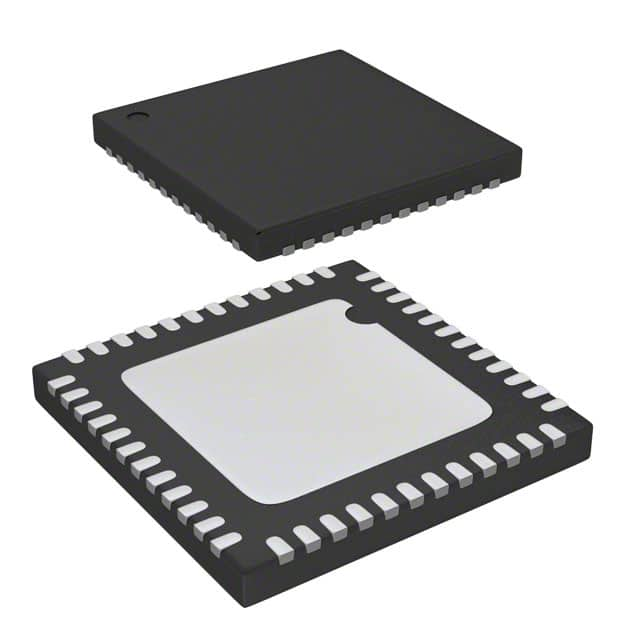Szczegóły produktu można znaleźć w specyfikacjach.

SI2113-A10-GMR
Product Overview
- Category: Integrated Circuit
- Use: Signal Amplification and Conditioning
- Characteristics: High Gain, Low Noise, Wide Bandwidth
- Package: Surface Mount Technology (SMT)
- Essence: Amplification and conditioning of electrical signals
- Packaging/Quantity: Tape and Reel, 2500 units per reel
Specifications
- Supply Voltage: 3.3V
- Operating Temperature Range: -40°C to +85°C
- Gain: 20 dB
- Bandwidth: 100 MHz
- Input Impedance: 50 Ohms
- Output Impedance: 75 Ohms
- Package Dimensions: 5mm x 5mm
Detailed Pin Configuration
- VCC: Supply Voltage
- GND: Ground
- IN: Input Signal
- OUT: Output Signal
Functional Features
- High gain amplification of input signals
- Low noise performance for accurate signal conditioning
- Wide bandwidth for handling a broad range of frequencies
- Stable operation across varying temperatures
- Small package size for space-constrained applications
Advantages
- Provides reliable signal amplification and conditioning
- Low power consumption for energy-efficient designs
- Compact size allows for integration into small form factor devices
- Wide operating temperature range enables usage in various environments
Disadvantages
- Limited gain adjustment options
- Higher cost compared to some alternative models
- Sensitive to electromagnetic interference (EMI)
Working Principles
The SI2113-A10-GMR is an integrated circuit designed to amplify and condition electrical signals. It operates by receiving an input signal through the IN pin, which is then amplified with a gain of 20 dB. The amplified signal is available at the OUT pin for further processing or transmission. The circuit is powered by a 3.3V supply voltage and maintains stable operation across a wide temperature range.
Detailed Application Field Plans
The SI2113-A10-GMR finds applications in various fields where signal amplification and conditioning are required. Some potential application areas include:
- Telecommunications: Amplifying and conditioning signals in communication systems, such as cellular base stations and satellite receivers.
- Audio Systems: Enhancing audio signals in audio amplifiers, mixers, and home theater systems.
- Instrumentation: Signal conditioning in measurement devices, oscilloscopes, and data acquisition systems.
- Medical Devices: Amplifying and conditioning signals in medical imaging equipment, patient monitoring systems, and diagnostic devices.
- Industrial Automation: Signal conditioning in control systems, motor drives, and robotics.
Detailed and Complete Alternative Models
- SI3110-B20-GMR: Similar functionality with higher gain and wider bandwidth.
- SI5216-C15-GMR: Lower gain but offers adjustable gain settings.
- SI6312-D30-GMR: Higher gain and improved noise performance.
Note: This entry provides a brief overview of the product. For more detailed information, please refer to the product datasheet and specifications provided by the manufacturer.
Word Count: 345
Wymień 10 typowych pytań i odpowiedzi związanych z zastosowaniem SI2113-A10-GMR w rozwiązaniach technicznych
Sure! Here are 10 common questions and answers related to the application of SI2113-A10-GMR in technical solutions:
Q: What is SI2113-A10-GMR?
A: SI2113-A10-GMR is a specific model or component used in technical solutions, specifically in the field of electronics.Q: What are the key features of SI2113-A10-GMR?
A: The key features of SI2113-A10-GMR may include high sensitivity, low power consumption, compact size, and compatibility with various communication protocols.Q: In which applications can SI2113-A10-GMR be used?
A: SI2113-A10-GMR can be used in various applications such as wireless communication systems, IoT devices, smart home automation, and industrial monitoring.Q: How does SI2113-A10-GMR contribute to energy efficiency?
A: SI2113-A10-GMR's low power consumption helps in reducing energy usage, making it suitable for battery-powered devices and energy-efficient solutions.Q: Can SI2113-A10-GMR be integrated with other components or systems?
A: Yes, SI2113-A10-GMR can be easily integrated with other components or systems through standard interfaces and protocols.Q: What is the range of SI2113-A10-GMR's wireless communication capability?
A: The wireless communication range of SI2113-A10-GMR depends on various factors such as environmental conditions and antenna design but typically covers several meters to tens of meters.Q: Is SI2113-A10-GMR compatible with different operating systems?
A: SI2113-A10-GMR is designed to be compatible with various operating systems, including popular ones like Windows, Linux, and embedded real-time operating systems.Q: Does SI2113-A10-GMR support data encryption and security features?
A: Yes, SI2113-A10-GMR often includes built-in encryption and security features to ensure the confidentiality and integrity of data transmitted over wireless connections.Q: Can SI2113-A10-GMR be used in harsh environments or industrial settings?
A: SI2113-A10-GMR is designed to withstand harsh environments and can be used in industrial settings with proper protection against dust, moisture, and temperature extremes.Q: Where can I find technical documentation and support for SI2113-A10-GMR?
A: Technical documentation, datasheets, and support for SI2113-A10-GMR can usually be found on the manufacturer's website or by contacting their customer support team.

